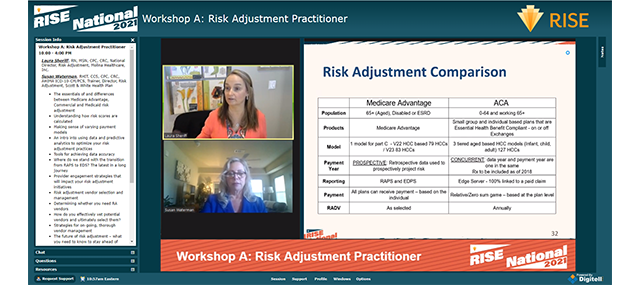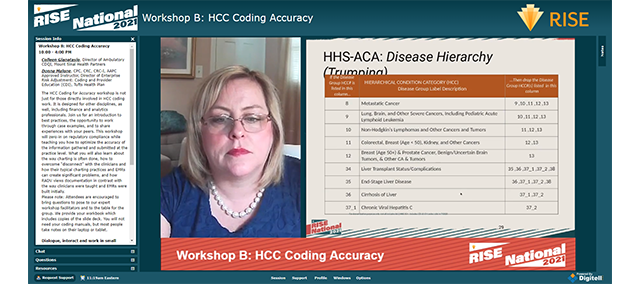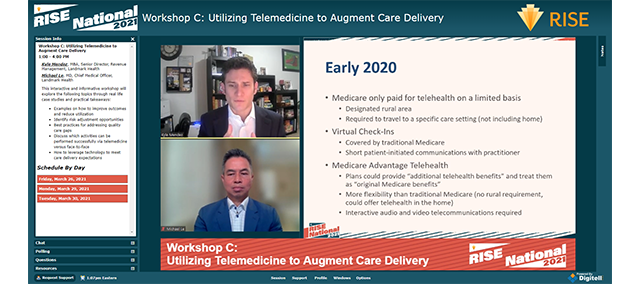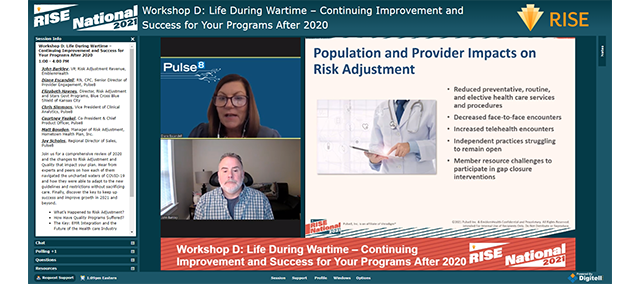RISE National is finally here! Our 2021 virtual summit kicked off Friday with pre-conference workshops, an inspiring family-friendly keynote, and virtual networking. If you missed it, we’ve got you covered. We’ve summarized the day below—and there’s still time to register for the main conference, which begins on Monday.
Preconference workshops on hot topics
Friday began with two of our popular full day workshops that offered deep insight into risk adjustment and HCC Coding.


During the interactive, deep-dive risk adjustment practitioner workshop, we explored the many aspects of risk adjustment, delving into the Medicare Advantage, commercial, and Medicaid models. Molina Healthcare’s Laura Sheriff and Susan Waterman of Scott & White Health Plan reviewed the fundamentals and different types of risk adjustment, provided a “30- foot view” of HCC coding, explained the financial impact and reconciliation, offered tools to achieve data accuracy, and discussed where the industry stands in the transition from RAPS to EDS. They also provided an update on telehealth risk adjustment and COVID-19, provider engagement strategies, vendor selection and management, steps to prepare for a RADV audit, and the future of risk adjustment.

Participants of the HCC Coding for Accuracy workshop spent six hours learning how to get the best chart documentation and most accurate diagnoses capture. Colleen Gianatasio, director of ambulatory CDQI, Mount Sinai Health Partners, led the interactive discussion, which included an explanation of the differences and similarities among the different risk adjustment models for Medicare Advantage, commercial, and Medicaid; diagnosis documentation and coding for risk adjustment, the financial impact of risk adjustment, and predictive modeling and quality.

The new half-day workshop on telemedicine to augment care delivery provided attendees with a look at how telehealth may look after the COVID-19 public health emergency is lifted. Landmark Health’s Kyle Mendez, MBA, senior director, revenue management, and Michael Le, M.D., chief medical officer, reviewed the rise of telehealth in early 2020, telehealth expansions that have come into place amid the pandemic, and what the future holds for telehealth beyond the public health emergency. The session also included a case study on how Landmark Health was able to improve outcomes and reduce utilization by leveraging telehealth as a key component of their model of care.

Another new half-day workshop on continued improvement and success for your programs after 2020 provided attendees with a comprehensive review of 2020 and the changes to risk adjustment and quality that impacted health plans. The panel explained how their organizations navigated the challenges of COVID-19 and adapted to the new guidelines and restrictions without sacrificing care. Panelists included John Barkley, VP, risk adjustment revenue, EmblemHealth; Diane Escandell, senior director of provider engagement, Pulse8; Elizabeth Haynes, director, risk adjustment and Stars government programs, Blue Cross Blue Shield of Kansas City; Chris Simmons, vice president of clinical analytics, Pulse8; Courtney Yeakel, co-president & chief product officer, Pulse8; and Matt Bowden, manager of risk adjustment, Hometown Health Plan, Inc.
Keynote: Tara Lipinski charms with her inspiring life story, tips to overcome stress

Following the workshops, main conference attendees were invited to join our virtual networking session, chat with one another, and enjoy a family-friendly interview between our conference chair Ana Handshuh, principal, CAT5 Strategies, and Olympic Gold Medalist Tara Lipinski.
Now a figure skating analyst for NBC Sports Group, when she was 15-years-old Lipinski became the youngest-ever gold medalist in her sport during the Olympic Winter Games in Nagano, Japan in February 1998. Lipinski told Handshuh how she got into the sport and handled the pressure and media attention at such a young age.
She began roller skating at the age of three for fun and became good enough to compete when she was 5-years-old. A coach suggested she try ice skating, so the following year she took to the ice and competed in both sports before giving up the wheels for good in favor of blades. Her days typically began at the ice rink at 7 a.m., where she trained until 3 p.m. and then went home and did schoolwork until 7 p.m.
“At 9, I was waking up at 5 a.m. and going on the ice at 5:30 a.m.,” she recalled. “Looking back, that was so much to handle,” noting she sacrificed her social life, school, friendships to train to become an elite athlete. “Now when I look back, I sometimes think, ‘how did I do that?’”
She remembered the nerves got to her at the Olympics in Japan after earning second place in the short program. The day of the long program, the final section of the competition, she thought she couldn’t do it and briefly thought about skating off the ice and leaving the arena. “I was under such extreme pressure,” Lipinski said. “I had worked for this my whole life and when the music started, my legs were shaking. But somehow I got in the zone and shook the nerves off.”
The zone is what Lipinski described as the ability to realize her body and mind was ready for this moment. As she skated by the judges and the media section to perform the long program, she remembers doubting her ability and then becoming angry at herself for sabotaging the moment. “I said to myself to cut it out. You trained for this. I went on autopilot and trusted my instinct and my ability. I don’t remember another second of the performance. I felt like I was floating for the rest of the skate.”
She describes her Olympic moment as a surreal experience when everything she worked for came together for four minutes and she skated her best program. “It was the happiest I ever felt,” Lipinski said. “I felt an overwhelming sense of relief, joy, and love for skating. I just think as an athlete it was one of the best moments of my life. When I finished the program, I didn’t have to be nervous and sitting, watching the score go up…it was a pinch me moment.”
Asked what parents can do to help their children face high pressure competitive situations, Lipinski said it’s important to have a support system but also truly love the activity. “I loved to skate so much, it balanced out the pressure I was under…You have to love it enough that it cancels out the other areas that are really difficult so make sure your kid is sort of in love with the sport. That will help and motivate them.”
In addition to her love of ice skating, one technique that is especially helpful even to this day is visualization, Lipinski said. A sports psychologist suggested she tape herself talking through her ice-skating program, including how it felt when she landed a move, and she’d fall asleep listening to the tape. The psychologist said that it would get into her subconscious and body. “It really worked on the tricks your mind plays and how to overcome those doubts,” she said.
Another tip, she said, is realizing that it is okay to be anxious and nervous. “It’s okay for them to be there and live with them. If you don’t make a big deal of them, at some point, they will go away,” she said.
Unlike other Olympic athletes, Lipinski didn’t have as much trouble transitioning to life after she came home. She decided to become a professional skater and began touring with other big-name skaters like Scott Hamilton and Kristi Yamaguchi. “I was lucky I had so much opportunity. But when I stopped touring in my early 20s, I hit a point when I was so tired and burned out. I never took off four consecutive days from skating because I was always training. It was the only life knew. So, after I stopped touring, I had a small adjustment period where I thought, ‘what do I do now?’”
Fortunately, she soon was faced with other opportunities that led to her working in front of the camera, providing commentary as a figure skating analyst. “I still skate but not to the degree I was. I still love being on the ice. It’s my safe haven. I’m drawn to it. Skating is so beautiful, it’s such a unique sport. You can do jumps, spins, fly through the air and create and be an artist and draw your painting,” she said.
Lipinski said she is now enjoying her life as a broadcaster with her best friend, American figure skater Johnny Weir. She’s also working on a three-hour television series for Peacock with her husband, director Todd Kapostasy. “It’s our first project together and experiencing that part of life with him is fun,” she said.
Like everyone, this part year has been difficult for Lipinski due to the COVID-19 pandemic. But she said the experience has made her grateful for her family and friends. “It makes me realize what’s important. It really comes down to health, love for the people in my family, and friends… as difficult as the year has been, I try to find the silver lining. Connections, health. That’s what matters.”
